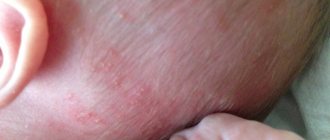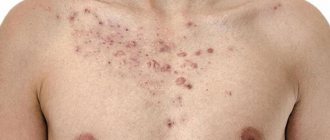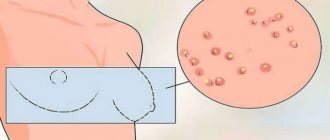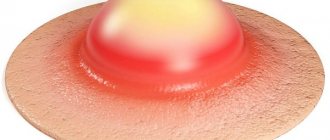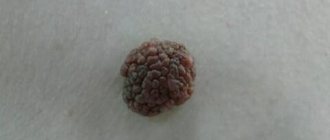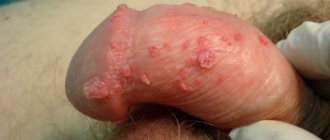Sebaceous glands are a component of the skin.
There are also a lot of them on the skin of the penis.
After the formation of the sebaceous glands during puberty, they take the form of small white tubercles.
The location is the base of the penis.
A change in color, size, number of tubercles, as well as their appearance on the mucous membrane of the head of the penis indicates the onset of pathology.
What causes their appearance and the reason for the changes can be found out by visiting a doctor.
After the diagnosis, the doctor will be able to make a diagnosis and give recommendations on further actions.
It all depends on the reason that provoked the appearance or change of the tubercles.
It will not be superfluous to pay attention to the presence of symptoms such as the appearance of rashes, itching, redness, irritation, and soreness.
What tubercles may appear on the penis
If small white tubercles have formed on the skin of the base of the penis, then this is normal.
Their formation occurs during puberty, which is associated with the influence of sex hormones.
If the sebaceous gland becomes inflamed, the tubercle on the penis becomes painful and turns red.
If a man leaves these changes unattended, the formation will increase and pus will begin to form in it - a boil will form.
The main cause of the pathology is the presence of a nonspecific infection.
Most often this occurs due to insufficient genital hygiene.
If a tubercle similar to a cauliflower inflorescence appears, you should immediately consult a doctor.
Typically, such rashes (condylomas) appear due to infection with papillomavirus (HPV).
The head of the penis normally has a smooth surface.
If tubercles appear on the head of the penis, this can be caused by various reasons, including:
- damage by a viral infection (HPV), which is accompanied by the formation of condylomas
- if one large tubercle or several of them appear on the penis, this may be due to the expansion of the walls of blood vessels
- development of an oncological disease, which results in the formation of a malignant neoplasm
In some cases, with active activity of the sebaceous glands, small tubercles may appear along the edge of the coronal groove of the head of the penis, which is normal.
Treatment
The choice of treatment method for the disease depends on the nature and cause of the pathology:
- If a boil has formed on the penis, local antibacterial agents and compresses are prescribed. Most often, Vishnevsky ointment is prescribed for boils. It helps speed up the maturation of the abscess, its opening and cleansing of pus. If the pathology occurs against the background of decreased immunity or a viral disease, then antiviral drugs and agents to strengthen the immune system are additionally prescribed.
- Acne with folliculitis is treated with brilliant green, fucorcin or camphor alcohol. Ichthyol ointment helps a lot. The man is prescribed general tonics to be taken orally. If the disease is caused by a herpes infection, antiviral and antibacterial agents are prescribed.
- Treatment of atheromas is surgical. The neoplasm is opened, and the cavity is cleared of contents and cystic tissue to prevent relapse. After the autopsy, local agents are prescribed to treat the wound and drugs to strengthen the defenses.
- For malignant tumors, after their surgical removal, radiation or chemotherapy is performed. This reduces the likelihood of disease relapse and metastases.
- The most appropriate treatment for Peyronie's disease is surgery. After the operation, medications are prescribed: vitamin E, drugs to reduce fibrinogen concentrations, anti-inflammatory drugs, drugs to strengthen the immune system.
- If the pathology is caused by contact dermatitis, then antihistamines (systemic or local) are prescribed. The success of treatment is guaranteed only if contact with the allergen is avoided.
Causes of the appearance of tubercles on the penis
The reasons for the formation of tubercles on the genital organ are associated with various pathologies.
They can occur as a result of injury, after unprotected sex, when personal hygiene rules are ignored, or the development of malignant neoplasms.
✔ Lymphangitis
The pathology is characterized by the formation of a painless, compacted lymphatic vessel on the penis.
Most often it occurs as a result of bacteria entering through damaged skin.
In the presence of a mild form, the symptoms disappear on their own.
If the pathology develops against the background of vascular injuries, complications may occur:
- pain joining
- pus formation
- temperature increase
- presence of general weakness
Usually, the pathology is a secondary infection against the background of a purulent-inflammatory focus, abscess, boil, wound or abrasion.
Sometimes, this symptom may indicate the presence of tuberculosis.
Moderate and severe forms of lymphangitis can provoke the development of thrombophlebitis, phlegmon, abscess, and sepsis.
✔ Folliculitis
A pathological focus is formed due to improper hair growth, which can provoke an inflammatory process in the hair follicle.
The tubercles are localized at the base of the penis.
The skin around the hair becomes red and an abscess forms.
Pathology can occur as a result of:
- increased sweating
- ignoring personal hygiene rules
- formation of minor injuries on the skin
- irritation after applying compresses
The causative agent is most often a staphylococcal infection, but can also be caused by viruses, fungi, and demodex mites.
Symptoms of folliculitis are characterized by:
- the appearance of hyperemia
- presence of swelling
- itching
- unpleasant sensations
Typically, the appearance of tubercles occurs in the initial stages of development.
The development of the disease is promoted by shaving hair in the groin and pubic area.
Folliculitis can occur in acute and chronic forms.
More often the disease is acute.
In the presence of a chronic form, men complain of itching.
On palpation, enlargement of the inguinal lymph nodes may be noted.
✔ Pearlescent papules
A feature of such formations is the presence of small, painless tubercles with a shiny surface.
Their location is the coronal groove of the penis.
The formation of pearly papules is not associated with pathological processes and only causes psychological discomfort to a man.
There are no indications for their removal, since this is not a disease.
If the pearlescent tubercles are damaged during sex, they can be removed.
A man who has pearly papules on his penis cannot be a source of infection for his sexual partner.
✔ Furuncle
Most often, a boil forms due to untreated folliculitis.
In the absence of therapy, a carbuncle (several boils) may develop and an abscess may form (purulent tissue inflammation followed by necrosis).
The boil looks like a lump, in the area of which there is severe pain.
Subsequently, it is filled with purulent contents and opened independently or through surgery.
The pathology most often affects young men.
A painful tubercle forms on the penis, only in the place where the hair grows.
The formation of a boil on the head of the penis does not occur.
The reasons for the formation of boils may be associated with lack of hygiene, wearing tight-fitting synthetic underwear, and hair removal.
And also the formation of purulent tubercles can occur with excessive functioning of the sebaceous glands.
✔ Lichen planus
The reason for the formation of lumps on the penis may be due to the appearance of a red flat. depriving.
An itchy rash appears on the genitals.
The pathology most often affects middle-aged men.
Scratching can lead to secondary infection.
When tubercles form on the penis, the head is involved in the process.
The disease often manifests itself while taking certain medications, including:
- tetracycline antibiotics, streptomycin
- drugs that lower sugar levels in the body
- antimalarials
- neuroleptics
- aminosalicylic acid
- gold preparations
- ACE inhibitors – enalapril, captopril
- thiazide diuretics
✔ Psoriasis
The appearance of a lump on the genital organ can be caused by psoriasis.
The plaque has an oval or round shape, a pink tint and clear boundaries.
The surface of the tubercle may be covered with white scales.
When you try to scrape off the plaque, a drop of blood appears - the phenomenon of blood dew, which confirms the presence of psoriasis.
The onset of the pathological process can be sudden or gradual.
The disease is chronic and practically untreatable.
The bumps can be present on the skin, including the penis, for years.
Often the pathology provokes the development of inflammation of the joints (arthritis).
✔ Lichen pellucida
The appearance of white bumps on the genitals can be the cause of lichen planus.
The pathology is manifested by the formation of a nodular rash on the skin.
There are many rashes, but they are located separately.
The disease is often chronic.
The tubercles, once appearing on the penis, exist for a long time, and then also suddenly disappear.
The disease is not dangerous.
✔ Papillomavirus
HPV can cause the formation of tubercles on the penis, which are commonly called condylomas.
Infection with papillomavirus occurs through sexual contact, but manifestations of the disease will appear only after some time.
The pathology is manifested by the formation of tubercles in the anogenital zone.
The shape and size of condylomas may vary.
They can be formed in different quantities.
The color of the formations is pink or close to the shade of the skin.
In some cases, the appearance of tubercles can lead to the development of a malignant neoplasm if they are provoked by an oncogenic type of HPV.
Under a number of circumstances, condylomas can become injured and even tear off, which can cause bleeding and secondary infection.
Condylomata injuries increase the risk of contracting viral hepatitis or HIV through sexual contact with partners who have these diseases.
Do women have education?
In women, such formations have a different histological structure. In representatives of the fairer sex, pearl-colored papules are formed as a result of disruption of the apocrine sweat glands. These formations appear in the area of the labia, groin, nipple halo, pubis, armpits, and red border of the lips. White papules have a pearlescent tint and a hemispherical shape. The reason for their appearance is hormonal changes in the female body during adolescence and genetic predisposition. Some studies indicate a connection with the functional state of the thyroid gland and ovaries.
Pearlescent nodules do not cause discomfort. There is a decrease in their number during menopause. This means that the nature of the formations is hormonal.
With the advent of menopause, a decrease in the production of sex hormones occurs, which reduces the secretion of apocrine glands and the number of pearly small papules.
Lump on penis after sex
The formation of tubercles on the penis after sexual intercourse can be caused by a sexually transmitted infection or trauma to the organ.
Sexual infections that can cause growths are syphilis, papillomavirus and genital herpes.
- When infected with syphilis, a hard chancre is formed, most often a single one. Sometimes it resembles a bump.
- With HPV, condylomas or warts form after a certain period of time.
- When infected with genital herpes, many blisters appear. In appearance, they look like tubercles filled with liquid.
In some cases, a lump may form if a man rubs his genitals during sex.
This can happen if there is damage to the skin.
Or it is associated with the presence of nonspecific inflammation, in which swelling, hyperemia, suppuration and pain will be expressed.
Tests for the appearance of tubercles on the penis
The appearance of tubercles on the genital organ requires special attention.
To understand what is causing the appearance of pathological formations on the penis, you need to undergo an examination.
There are a number of factors to consider:
- localization of compaction in the skin
- education color
- presence of content in it
- the tubercle may be associated with blockage of the gland or pose a risk of malignancy
The appearance of a tubercle may be accompanied by:
- the appearance of edema
- presence of hyperemia
- pathological discharge from the urethral canal
- peeling
- the appearance of itching and burning
Before making an initial conclusion, the doctor will listen to the patient’s complaints.
After collecting anamnesis and palpation, the doctor will examine the patient’s penis and evaluate the tubercles for the presence of pathology.
Depending on the location, size and shape of the formations, the doctor can make a preliminary diagnosis.
The list of tests is compiled based on the data obtained from the survey and examination of the man.
- If there are manifestations of human papillomavirus infection, PCR is prescribed. The technique is based on determining fragments of the virus genotype in a sample. If HPV turns out to be oncogenic, the patient will have to undergo tests to determine whether the tumors have degenerated into a cancerous tumor.
If there are indications, a histological examination of the condyloma after its removal may be prescribed.
This measure allows us to give an adequate assessment of the risk of malignancy.
Since infection with papillomavirus occurs during sexual intercourse, a man can often acquire a bunch of other STIs along with HPV.
To do this, smears from the urethra are examined using microscopy and bacterial culture.
- If you suspect the presence of lichen planus, the doctor will recommend a histological examination of the area of the affected skin. Signs of the disease are Wickham's grid - whitish striations, which become noticeable after applying Vaseline to the affected part, when viewed under a magnifying glass.
- Koebner's phenomenon can occur if a man rubs the skin on his penis and a lump appears in this place.
- Psoriasis can be diagnosed by a doctor based on external symptoms. Histological examination will reveal:
- thickened epidermis;
- the presence of an inflammatory reaction;
- the nucleus is retained in the epidermal cells;
- a large number of fibroblasts and keratinoids are at the division stage.
PCR tests may be prescribed to confirm the diagnosis.
If the inflammatory process is pronounced, then bacterial culture is carried out.
Growths on the head in men: photo, description, removal
The growths on the head of the penis look like dense pimples or warts. They are frightening and immediately suggest a terrible disease. But most often such defects are relatively harmless. To accurately determine the type of tumor, a comprehensive diagnosis is necessary. It is important to distinguish between types of growths, because each of them requires a specific approach.
Types of neoplasms on the genitals
In men, growths are most often white and red, less often flesh-colored. You need to understand that some of them are not considered a pathology and do not require treatment/removal. Let's take a closer look at each of them.
Pearly papules
They are also called hirsutoid papillomas or pearl necklace around the glans. They are cone-shaped or thread-like growths with a matte-shiny flesh-colored surface. Sometimes they are so small that they look like small pimples.
Papillomas are located close to each other, but do not merge. All elements have the same size, which does not change over time. Papules are localized around the circumference of the crown or on the head itself in 1-2 rows.
The formation of hirsutoid papillomas is not accompanied by itching, burning and pain.
Pearl necklace does not pose a health risk and is not contagious. This is overgrown connective tissue of the gland ducts. Therefore no treatment is required.
Despite this, many men want to remove pearlescent papules for cosmetic reasons. Medicine offers several modern methods at once, from cryotherapy to laser.
It should be remembered that there is no guarantee of their reappearance. And the removal procedure itself, it must be said, is not cheap.
Fordyce granules
White growths on the head of the penis are seborrheic cysts. They look like white or yellowish nodules about 1 mm in diameter. They are usually numerous and located in groups. Appear on the head and shaft of the penis. There is no physical discomfort.
Although granules appear due to developmental abnormalities, they are not a pathology. In some people, the sebaceous glands are located closer to the epidermis than they should be. With a hormonal surge, especially in young men in adolescence, there is an increased production of sebum. The gland ducts become clogged and Fordyce granules appear. Since it is not a disease, no treatment is needed.
Molluscum contagiosum
It is characterized by the appearance of small flat nodules on the skin of the penis, which quickly increase in size and reach 5-7 mm in diameter. The formed mollusk is hemispherical in shape and flesh-colored.
At first it is hard, then it becomes softer. A depression with a white dot forms in the central part of the growth. When pressed, a cheesy plug comes out. Single rashes or groups of up to 10 pieces are possible.
The elements can merge, forming a large lesion up to 2 cm in diameter.
Molluscum contagiosum on the genitals is transmitted sexually. The causative agent is a type of smallpox virus. But only the skin is affected, and people with normal immunity do not experience complications. The rash disappears on its own within six months. After the last element dies off, the virus completely disappears from the body.
Chancre
Red growths on the head in men can be a sign of syphilis. Hard chancre is a hemispherical compaction of flesh-red color with a smooth and shiny surface.
There is no bleeding or physical discomfort. Possible simultaneous enlargement of lymph nodes. The neoplasm lasts 6-7 weeks, after which it disappears.
Then secondary syphilis begins with extensive damage to the skin and internal organs.
A chancre appears at the site of introduction of the causative agent of the disease - Treponema pallidum. Transmitted primarily through sexual contact. Infection through blood is also possible. Household transmission is rare. It should be remembered that at the initial stage it may appear as a small red spot on the head of the penis, which quickly increases in size.
Papilloma
A skin growth in the form of a ball on a thin stalk or flat base. There are cone-shaped elements called genital warts. They can grow and merge with each other, forming lesions in the form of cauliflower or cockscomb. There are no subjective sensations, only slight itching is possible.
The causative agent of the disease is the human papillomavirus. It is transmitted primarily through sexual contact. Infection from mother to child during childbirth or breastfeeding is also possible. It is believed that the virus is constantly in the body of about 90% of people. But only people with weakened immune systems get sick. Self-healing is possible if you live a healthy lifestyle.
Growths on the head in men photo
Fordyce granules and pearlescent papules do not require treatment. For molluscum contagiosum, antiviral therapy is needed only for people with weakened immune systems. There is no cure for HPV, but you can temporarily “put to sleep” the virus with the help of special medications.
Condylomas must be removed if they are caused by an oncogenic type of virus. The remaining growths are destroyed for aesthetic reasons. The surgeon does this using one of the following methods:
- laser coagulation;
- electrocoagulation;
- radio wave exposure;
- cryodestruction.
The chancre is not removed; syphilis is treated with antibiotics.
Growths on the glans in men can be extremely dangerous, but most often they are only a cosmetic defect. To accurately determine the type of tumor, you need to take a blood test and a PCR smear. If there is no danger, it is better not to touch the growths. They will still appear again over time, and any intervention can result in complications.
Source: //andrologiya.com/narosty-na-golovke-u-muzhchin.html
How to treat tubercles on the penis
Since the reasons for the formation of pathological tubercles vary, it is difficult to give general recommendations on what to anoint or what antibiotics to take to get rid of the problem.
The doctor must decide which patient will receive treatment based on the diagnosis.
Medicines with a narrow focus and general action (immunostimulants, vitamins) can be used.
In the presence of papillomavirus infection, podophyllotoxin is used, which is applied to the affected areas.
As a result, the tubercles disappear, but not always.
Sometimes after disappearing, they appear again.
Therefore, it is better to resort to genital wart removal.
The procedure is performed under local anesthesia, so the patient will not feel pain.
To prevent relapses, the doctor will prescribe immunomodulators to increase the body's immune defense.
Lichen planus is treated with corticosteroids.
Use external means.
If there is severe itching, injections are given into the affected areas.
In case of a severe process, Cyclosporine and corticosteroids are used orally, which help reduce pain and itching.
Systemic treatment is given if the bumps develop into ulcers.
If drug therapy does not provide the desired effect, irradiation of the affected area (PUVA) is performed.
For the treatment of psoriasis, external agents containing fluorinated glucocorticoids are prescribed.
Preference is given to drugs with maximum effect.
Glucocorticoid therapy should not be carried out continuously to prevent skin atrophy.
Creams containing vitamin D are also recommended, and Triamcinolone is used intradermally if indicated.
If a man has furunculosis, folliculitis or lymphangitis, antimicrobial therapy with antibiotics is carried out.
If the process is not started, then local treatment with ointments, solutions, gels with antibiotics and antiseptics is often sufficient.
In case of complications, surgical intervention is performed.

